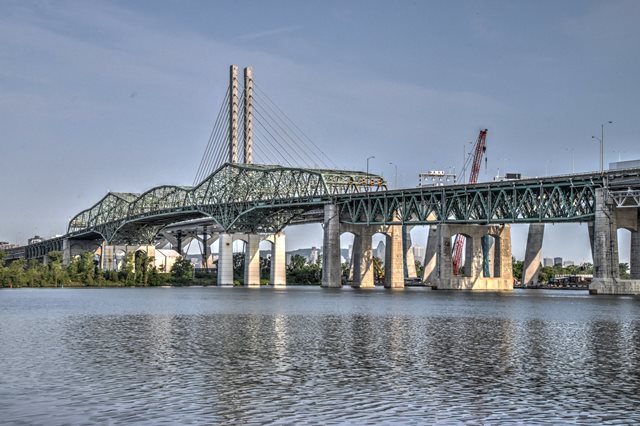We Recommend:
Bach Steel - Experts at historic truss bridge restoration.
BridgeHunter.com Phase 1 is released to the public! - Visit Now
Pont Champlain (Champlain Bridge)

Primary Photographer(s): Nathan Holth
Bridge Documented: July 11, 2019
Autoroute 10, Autoroute 15, and Autoroute 20 Over St. Lawrence River (Fleuve Saint-Laurent)
Montréal and Brossard: Montréal, Québec and Montérégie, Québec: Canada
Metal Cantilever Bolt-Connected Warren Through Truss, Fixed and Approach Spans: Metal Bolt-Connected Warren Deck Truss, Fixed
1962 By Builder/Contractor: Dominion Bridge Company of Montréal, Québec and Engineer/Design: Philip Louis Pratley and Henry Hugh Lewis Pratley
Not Available or Not Applicable
707.0 Feet (215.5 Meters)
11,286.0 Feet (3440 Meters)
74 Feet (22.56 Meters)
3 Main Span(s)
Not Applicable

View Information About HSR Ratings
Bridge Documentation
This bridge no longer exists!
Bridge Status: This bridge has been replaced and as of January 2022, the main suspended span of the bridge has been removed as part of a multi-year demolition project!This large cantilever truss bridge, noted for its impressive width as much as its length, was replaced and demolished. The bridge was designed by Philip Louis Pratley and Henry Hugh Lewis Pratley. Philip Louis Pratley (who would have been in his 70s when this bridge was built) was a famous Candian engineer who served on the Government Board of Engineers for the famous Pont de Québec. Other involved engineers were Philippe Ewart as well as Lalonde and Valois. Dominion Bridge was the contractor for the bridge. Additional involved contractors were Atlas Construction Company Limited, McNamara (Quebec) Limited, The Key Construction Inc., and Deschamps & Bélanger Limitée. A lot of concrete bridges in Montréal seem to have suffered from a lot of deterioration. Certainly the use of winter deicing salts contribute to this, but certainly this isn't the only city in Canada to see snow. Its not clear why so many concrete overpasses and bridges in Montreal have a lot of concrete deterioration. In any case, this bridge was no exception with the concrete approach spans deteriorating severely. In its final years of use, supplemental post-tensioning and trusses were added to stabilize the approach spans. At the time of its closure, the bridge was the busiest bridge in Canada.
The main cantilever span was about 707 feet, while the three main spans combined measured about 1,475 feet. The total length of the truss spans of the bridge, including three cantilever truss spans, and four deck truss spans was about 2,500 feet.
The loss of this bridge is unfortunate in the sense that it was a major engineering project, designed and built largely by Canadians, and probably one of the last major projects associated with famous Canadian engineer Philip Louis Pratley. In contrast, the replacement bridge was buiit by a United States based multi-national engineering company, T. Y. Lin. The replacement bridge is a typical modern cable-stayed bridge, a bridge type that is currently uncommon locally, but is the most common type of large-span bridge built today, and is downright common in places that have failed to preserve heritage bridges like Vancouver. It is hoped that the surviving major bridges in Montréal will be carefully maintained and preserved so that cable-stayed bridges remain uncommon in the area. While this was a significant heritage bridge, it was not as significant as the other surviving major heritage bridges in the city.
Note that when HistoricBridges.org visited Montréal, this bridge had already been closed to traffic, so the photos were taken from beside the bridge only.
A website visitor offered some hints as to why many concrete bridges in Montreal seem to have deteriorated concrete:
From the concrete perspective the higher deterioration has to do with an expansive reaction that occurs between the aggregate and the high pH of the pore solution in the concrete (the alkali-aggregate reaction). Reactive aggregate that can cause AAR is in a lot of quarries around Montreal.
![]()
Photo Galleries and Videos: Pont Champlain (Champlain Bridge)
Bridge Photo-Documentation
Original / Full Size PhotosA collection of overview and detail photos. This gallery offers photos in the highest available resolution and file size in a touch-friendly popup viewer.
Alternatively, Browse Without Using Viewer
![]()
Bridge Photo-Documentation
Mobile Optimized PhotosA collection of overview and detail photos. This gallery features data-friendly, fast-loading photos in a touch-friendly popup viewer.
Alternatively, Browse Without Using Viewer
![]()
Maps and Links: Pont Champlain (Champlain Bridge)
This historic bridge has been demolished. This map is shown for reference purposes only.
Coordinates (Latitude, Longitude):
Search For Additional Bridge Listings:
Additional Maps:
Google Streetview (If Available)
GeoHack (Additional Links and Coordinates)
Apple Maps (Via DuckDuckGo Search)
Apple Maps (Apple devices only)
Android: Open Location In Your Map or GPS App
Flickr Gallery (Find Nearby Photos)
Wikimedia Commons (Find Nearby Photos)
Directions Via Sygic For Android
Directions Via Sygic For iOS and Android Dolphin Browser

